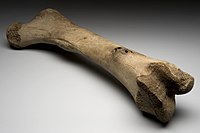
Photo from wikipedia
Purpose of Review The goal of this review is to highlight the deficits in muscle and bone in children with cerebral palsy (CP), discuss the muscle-bone relationship in the CP… Click to show full abstract
Purpose of Review The goal of this review is to highlight the deficits in muscle and bone in children with cerebral palsy (CP), discuss the muscle-bone relationship in the CP population, and identify muscle-based intervention strategies that may stimulate an improvement in their bone development. Recent Findings The latest research suggests that muscle and bone are both severely underdeveloped and weak in children with CP, even in ambulatory children with mild forms of the disorder. The small and low-performing muscles and limited participation in physical activity are likely the major contributors to the poor bone development in children with CP. However, the muscle-bone relationship may be complicated by other factors, such as a high degree of fat and collagen infiltration of muscle, atypical muscle activation, and muscle spasticity. Muscle-based interventions, such as resistance training, vibration, and nutritional supplementation, have the potential to improve bone development in children with CP, especially if they are initiated before puberty. Summary Studies are needed to identify the muscle-related factors with the greatest influence on bone development in children with CP. Identifying treatment strategies that capitalize on the relationship between muscle and bone, while also improving balance, coordination, and physical activity participation, is an important step toward increasing bone strength and minimizing fractures in children with CP.
Journal Title: Current Osteoporosis Reports
Year Published: 2020
Link to full text (if available)
Share on Social Media: Sign Up to like & get
recommendations!